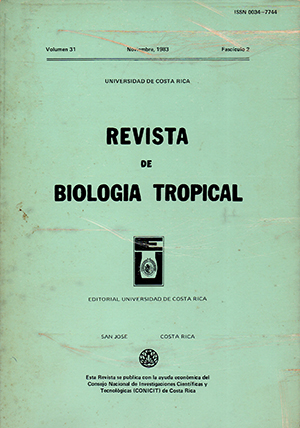Abstract
Phonological characteristics and reproductive efficiency of the aroid Dieffenbachia oerstedii were studied in two populations in the Central Valley, Costa Rica (along streams on the Pacific drainage). Most inflorescences were produced in May and June, and ripe fruits (exposed by dehiscence of the spathe) were observed a year later in June. Most (90 %) of reproductive plants produced one or two inflorescences, a few produced three per season and only one produced four (out of 151 inflorescences observed). Production of new leaves dropped considerably during the blooming period. Number of fruit per infructescense varied from 13 to 43; each fruit containing one green seed. Seed color was different (red or pink) in those producing nonviable albino plants (129 out of 728 seeds used in germination observations, i.e., 17.7%). Some seedless fruits were also observed, which might function as a reinforcement for the well-established ornithocory in this species, since these and the fruits with nonviable seeds would be an extra reward for frugivory. Emphasizing this idea, seeds seem to require some kind of abrasive action (like passing through the digestive tract of a bird) to germinate, since seeds covered by intact pericarp failed to germinate in all trials, whereas naked seeds germinated in nearly 100% of the experiments.References
Croat, T.B. 1980. Flowering behavior of the Neotropical Genus Anthurium (Araceae). Amer. J. Bot., 67: 888-904.
Pijl, L. van der. 1982. Principles of Dispersal in Higher Plants. Springer-Yerlag, Berlin. 215 p.
Ramírez, W., & L.D. Gómez. 1978. Production of nectar and gums by flowers of Monstera deliciosa (Araceae) and of some species of Clusia (Gutiferae) collected by New York Trigona bees. Brenesia, 14-15: 407-412.
Yalerio, C.E., & E. Yillalobos. 1980. Polinización y eficiencia reproductiva en Anthurium scandens (Araceae). Brenesia, 18: 137-146.
Williams, N.H., & R. L. Dressler. 1976. Euglossine pollination of Spathiphyllum (Araceae). Selbyana, 1: 349-356.
Croat, T. B. Dieffenbachia (Loterías, Dum Cane), p. 234-236. In D. H. Janzen (ed.) Costa Rican Natural History. University of Chicago Press.

This work is licensed under a Creative Commons Attribution 4.0 International License.
Copyright (c) 1983 Revista de Biología Tropical

